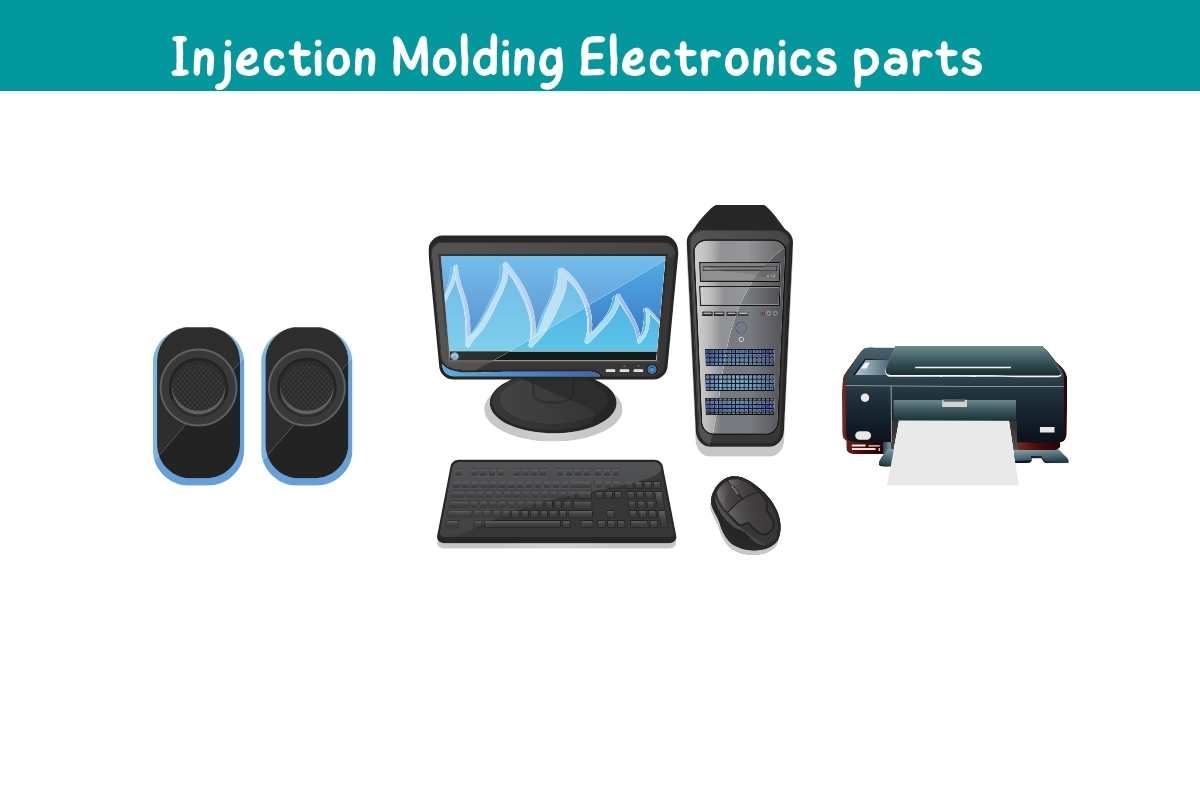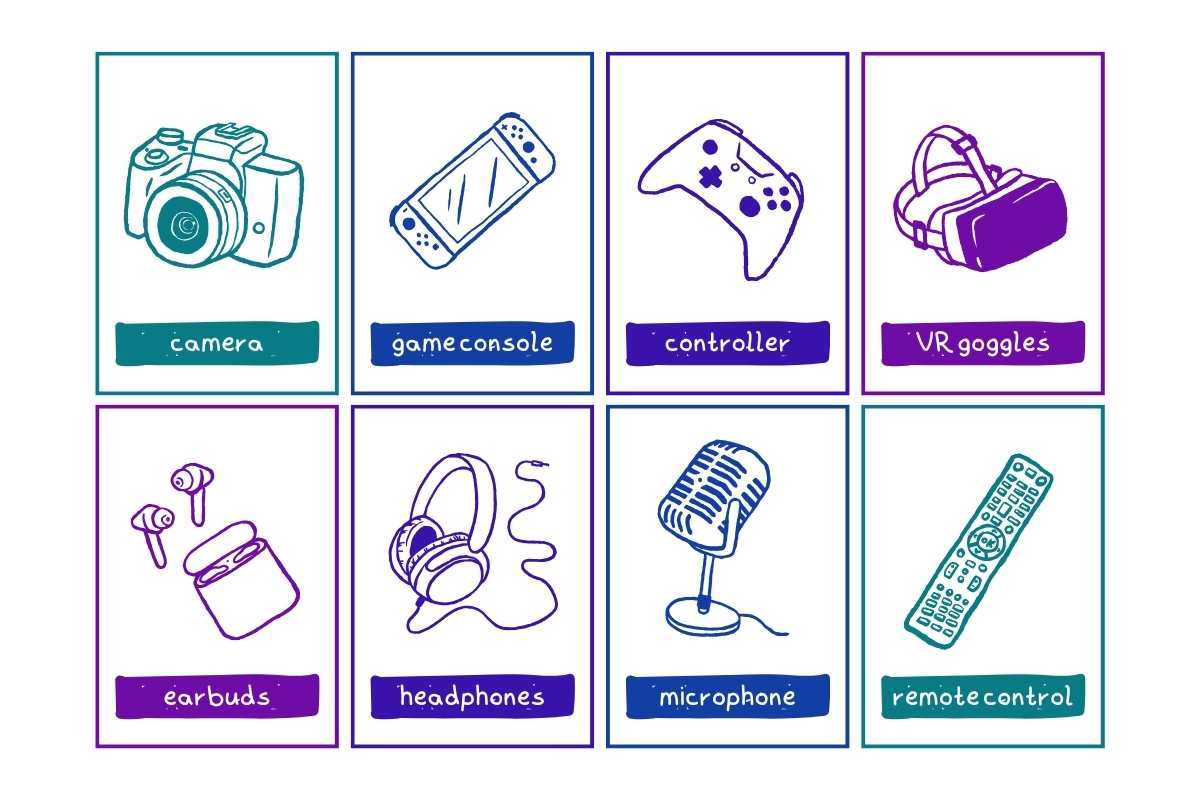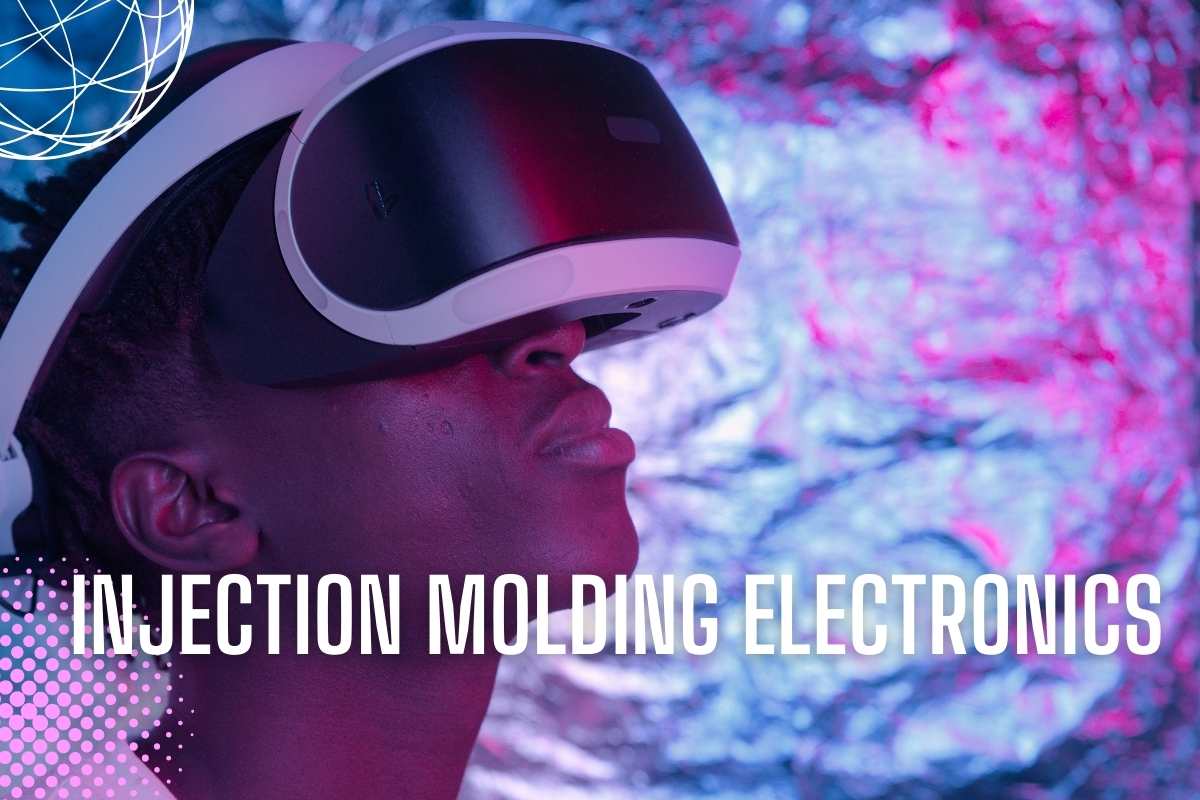What are Injection Molding Electronics
Injection molding electronics is electronic plastic components produced by the injection molding manufacturing process. There are lots of electronic devices that are using injection molding electronics method, those include control romotors, signal light, routoer, and many more.
The global injection molding industry is expected to increase at a compound growth rate of 4.8 percent from 2023 to 2030. The electronics industry is the largest consumer of this industry. Every device, from smartphones to laptops, has an injection-molded plastic part. Many important electronic components are made using different injection molding techniques. These can be insert molding, miniature molding, and over-molding. We will shed light on the advantages and complete procedures in the electronics injection molding industry.

Materials used in the Injection molding Electronics Industry
The manufacturing of different electronics is a complicated process. We use different plastic parts in electronics. Plastic materials can withstand harsh conditions. They can tolerate high temperatures and don’t deteriorate easily. Let us talk about different plastic materials used in injection-molded structural electronics. Some of them are:
1. PolyCarbonate
Polycarbonate is a tough and strong thermoplastic. So, it increases the life span of electronic devices. It can withstand high temperatures. Hence, it is a stable material. It is a good alternative to metal components. It is mostly used in electronic switches and compact discs (CDs). go to Polycarbonate injection molding to know more.
2. Polyamide
Polyamide is also known as nylon. It can tolerate temperatures up to 250 °C. So it is heat-stable. Moreover, it is chemically resistant. It can endure exposure to corrosive substances, oils, and solvents. It is an insulator. This property makes it excellent for use in electronics. It is mostly used in adapters, sockets, and cables.
3. Polypropylene
Polypropylene is the second most widely manufactured plastic after polyethylene. It has good insulating qualities, just like polyamide. It has a high melting point. As a result, it maintains thermal stability. It is predominantly utilized in medical devices. However, it can also be used in connectors, sockets, and battery components. Go to PP injection molding to know more.
4. High-Density Polyethylene
As the name indicates, it has a higher density than other polyamides. It has a melting point of 260 °C. So it is suitable for high-temperature applications. Moreover, it has high mechanical strength. So it is suitable for structural components. It has low moisture absorption. Hence, it prevents corrosion. It is used mostly in wire coatings and wire insulation.
5. Acrylonitrile Butadiene Styrene
ABS has intermediate strength. It cannot tolerate UV radiation. So it is not suggested for outdoor devices. It is a budget-friendly option. It can also be sterilized through gamma radiation. It is used for devices like computer cases, telephone handsets, and monitors.
6. Thermoplastic Urethane
It’s a flexible material. It can withstand tension and vibrations. It is very resistant to oils and grease. Additionally, it is a scratch-resistant polymer. It also possesses bonding characteristics. It can easily adhere to substrates such as metal and glass. It is widely used in the footwear sector. It is utilized in the production of shoe parts. However, it is also suitable for flexible printed circuit boards and flexible flat cables.
Complete Step-by-Step Process of Injection Molded Structural Electronics
The need for mini-electronics is increasing with increasing technology. Hence, modern methods can be used as a replacement for old techniques. So, let’s discuss an advanced technique to create injection-molded electronics.
1. Create a Design
The first step is to create a design. We will define the shape, size, and features of the device. Additionally, we will consider its electrical and thermal requirements. After that, we will optimize the design for better performance. We can use CAD software to make a design
2. Create a Mold
After making the design of your desired device, create a mold. It should have features and shapes according to our product design. Ensure that the mold can endure high temperatures and pressure. We may use CNC machining or 3D printing to create a mold.
3. Injecting the Material
The next step is to insert plastic material into the injection molding machine. We will heat the plastic. So, it will melt. Now we can inject it into the mold. We will apply high pressure to fill the mold evenly.
4. Solidification and Cooling
Mold contains specific cooling channels. The plastic makes contact with the mold. As a result, convection removes the majority of the heat. Some heat is lost due to heat waves that radiate. As the plastic cools, the molecules become closer together. As a result, solidification occurs. Plastic shrinks when it solidifies. Following that, the mold opens. Thus, the plastic is ejected.
5. Metallization
Next comes the metallization. It means applying a thin layer of conductive material to an insulator. We must ensure that the conductive material is applied uniformly to the plastic surface. The conductive material can be silver or copper. We will then add a chemical activator to enhance the bonding process.
6. Electronic Component Addition
After metallization, we will add electronic components to the surface. We can place capacitors and resistors on the metalized structure. We can use surface mount technology or through-hole technology for placing electronic components.
7. Addition of Protective Material
Now the injection-molded structural electronics are manufactured. The final step is to coat electronic components with a protective layer. It shields the electronic components from environmental stress. It also prevents chemical corrosion and damage.

Advantages of Injection Molding Electronics
You are well aware of the complete process of electronic injection molding. So let’s talk about the advantages of injection-molded electronics
1. Budget-Friendly
The process can produce a high volume of electronic products at an affordable price. We use plastic parts in electronics as an alternative to other materials. For example, we can use steel parts instead of plastic. But steel is very expensive. So using plastic products is a cost-effective strategy. Moreover, unlike steel or metal, the plastic injection molding process requires less energy.
2. Insulation
Electrical appliances are at risk of overheating in factories, offices, and homes. According to a report, 183 fire incidents have been reported in Canada over the past few years. These are the overheating of mobile phones and other electronics. Plastic is a poor conductor of electricity. So it prevents the overheating of the electronic devices. As a result, it may lessen fire incidents due to electronic devices
3. Long life span
Metal can erode. Every other material is prone to corrosion. But if we choose a chemical-resistant plastic, it will prevent corrosion. Its thermostable nature allows it to function in harsh weather conditions. Thus, it will increase the life span of the injection-molded electronics.
4. Lightweight Products
Plastic is a light material. Using plastic materials in electronic devices makes them portable. Additionally, plastic is an easy-to-clean material. So, we can easily remove dirt from it.
5. Quick Manufacturing
Manufacturing plastic is not a time-consuming process. Its cycle time ranges from 2 seconds to five minutes. So we can produce a large number of injection-molded electronics in a short time.
Disadvantages of Injection Molding Electronics
Injection molding has many benefits to making electronic enclosures. It also has some limitations as well. Let’s discuss these here.
1. High Initial Costs
Injection molding may require significant initial costs due to the design and production of molds. So, these complex molds can be very expensive and are only suitable for large production volumes. Additionally, if there is any need to modify the designs, the molds will be redesigned, which will increase the cost and be very time-consuming.
2. Lead Time
The time required for making the molds that will be used in injection molding is relatively long in this process; hence, it may take longer before production begins. This is because, from the conception of the idea up to the time when it is implemented, the process takes time in this type of design. After all, it goes through different stages of prototyping to be able to achieve the desired outcome.
3. Material Limitations
The materials that can be utilized in injection molding carry certain restrictions on their choice. Originally, the material chosen for use in the bus must have certain thermal, electrical, and mechanical characteristics to suit the demanded electronic components. Moreover, it is worth stating that some injection molding materials can be difficult to recycle, thus posing an environmental concern.
4. Complexity in Mold Design
Injection molding entails stringent tolerances in the creation process to produce goods that fit the intended design as closely as possible, a process that is complicated and demands the application of skills. The chosen part designs have some limitations in terms of permitted geometries to avoid such problems as undercuts and some constraints on draft angles, which means that design freedom and creativity can be problematic in certain cases.
5. Production Issues
In injection molding, one can observe certain standard flaws that may be apparent on the enclosures; these include warping, sink marks, flow lines, etc. However, injection molding as a production technique can be rather efficient in terms of the cycle time, that is, the time it takes to produce a single part; at the same time, managing to minimize the cycle time and guarantee the quality of the produced parts is a rather intricate task.
6. Material Waste
Material wastage is also an issue because a large portion of the mold material used in the sprue cavity and the runners cannot be used unless the scrap material is reground and used, and this might not always be possible when high-performance materials are being used. Also, excessive designs like curvatures may require more material, which means more waste.

Challenges of Electronics Enclosure Injection Molding
Here are some of the challenges associated with injection molding electronics;
- Material Compatibility: One of the significant challenges is ensuring material compatibility. The plastic material must be compatible with the electronic components. It will prevent damage and corrosion. Choosing the right material is a complicated process. So, make sure to choose a material that meets the electrical and thermal requirements of electronic devices.
- Thermal Management: Thermal management is another challenge. The injection molding process generates heat. This heat can damage electrical components. So designing ventilation channels can help with thermal management.
- Mold Design and Manufacturing: It has relevantly high upfront costs to make complex molds. Besides this, it is also hard to maintain tight tolerances, which is critical to guaranteeing that the parts fit together correctly and function properly. Additionally, efficient cooling channels are also important to reduce cycle times and avoid warping.
- Quality Control: It is also very hard to ensure that parts maintain their dimensions and do not shrink or warp after cooling. Besides this, the surface finishing, i.e., smooth and textured, is also very challenging. It might also cause issues like sink marks, voids, or weld lines.
- Manufacturing Process: When we try to balance the cycle time with quality, it might increase efficiency but lead to defects. So, it becomes a challenge to maintain consistent part quality across large production runs. Besides this, it requires strict process controls. Moreover, managing material flow within the mold is also quite hard, so it can avoid issues like flow lines or incomplete filling.
Conclusion:
In conclusion, the injection molding electronics industry is gaining popularity. It generates valuable small electrical components. Various materials are utilized in injection molding electronics. Polycarbonate, nylon, and polypropylene are among the most widely utilized materials. The entire process is divided into numerous steps. The electronic device has a plastic component built into it. It has numerous benefits. It makes electronic gadgets lighter, more insulated, and last longer. The challenges related to the injection molding electronic process include thermal stability and material compatibility.
Frequently Asked Questions
Q1. Can we produce electronics using an injection mold?
Yes, we can produce various electronics using injection molding techniques. Some of the most commonly used are sensors, antennas, circuit boards, and connectors.
Q2. What type of electronic components can be produced using an injection mold?
Normally any type of electronic housing and components can use injection molding process, if you are not sure, welcome to send us, we are one of top 10 plastic injection molding companies in China, we will review it and quote you a competitive price.
Q3. How does electronic injection molding differ from traditional injection molding?
Both are injection molding process, only different for the final purpose using, if you haev any question welcome to contact us.
Q4. Can electronic injection molding be used to produce medical devices?
Yes, it can produce medical devices because the are many mecial devices are made by injection molding process. It mostly forms implantable devices and diagnostic equipment.
Q5. What is the typical shelf life of injection-molded electronics?
The typical shelf life of injection-molded electronics ranges from 3–5 years. It also depends on the materials used in the desired product.

